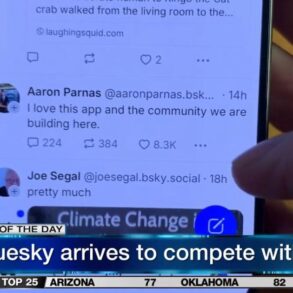Dani said it took just four months for her 13-year-old son to become “addicted” to the mobile phone app Snapchat.
“When he woke up in the morning … he’d go straight to the phone,” she said.
The Melbourne mum says she tried to put in place measures to restrict his usage — even drawing up a “contract” laying out the rules — but it wasn’t enough.
“There was a lot of notifications, constant notifications coming up on his phone … you couldn’t hold a conversation with him because he was wanting to check his notifications,” she said.
Several parents say their children have developed addictive behaviours towards the messaging app Snapchat. (ABC News: James Dunlevie)
The experience has made Dani a staunch supporter of the federal government’s move to ban social media for under-16s, which will come into effect from the end of 2025.
She said a ban would give her a more powerful reason to say no when her younger daughter asked her to join social media.
“It’s a blanket rule — it’s like my kid wanting to go and get a cigarette, it’s not happening,” Dani said.
“It’s black and white and that’s what I think, as parents, we are really craving at the moment.”
The ABC has spoken to several Australian parents to get a sense of how those who will be on the frontline of enforcing the ban feel.
Here’s what they told us.
One parent says Australia should be ‘proud’ for taking a stand
When Dani’s son asked for a Snapchat account, they agreed to a four-month trial.
He would be allowed an hour daily usage, phones would be kept downstairs at night, and he would only interact with friends.
It wasn’t enough.
Soon, 50 friends became more than 1,000, as he joined chat groups from other schools.
Several parents say it has been hard to manage their child’s relationship with social media. (ABC News: Paul Sellenger)
Dani said her son’s phone pinged constantly and the first thing he did every morning was go downstairs to check his phone.
He was told to remove himself from the chat groups.
“He was in tears, because when you remove yourself, it says ‘[they] have left the chat’, and you feel a bit ashamed as a kid, leaving that social circle and having that announcement,” Dani said.
That was one of many tools which, Dani believed, were put in place intentionally to stop children disengaging.
“It’s a system that perpetuates the feeling of FOMO [fear of missing out],” she said.
As her son’s Snapchat trial period came to an end, Dani read a story about a teenage victim of sextortion.
The victim had been tricked into sharing nude photos with someone he thought was a girl his age after only a few minutes of flirting.
He then received a phone call from a middle-aged man demanding cash or the picture would be circulated to all of the boys contacts — a threat that was later carried out.
The boy later took his own life. For Dani, reading that story was the final straw.
When Dani shared the story with her son and told him he would no longer be allowed to use Snapchat, she said he was defensive and upset.
“It was about nine o’clock on a Sunday night, and I thought — my child’s not going to speak to me for weeks,” she said.
“Then about half an hour later, I heard him trudging down the stairs, and he came up behind me, and I kid you not — he put his arms around me from behind, and he said: ‘Mum — thank you for being a great parent, I didn’t know how to tell you do, I was becoming addicted to Snapchat, and I just needed you to be firm’.
“I was in tears.”
The ban has drawn criticism for its rushed nature, and from academics who claim it won’t work.
But for Dani, the rapid response from the government felt empowering.
“I say power to them,” she said.
“I’m so proud to be in the country that puts this at the forefront of their agenda, and that they’ve listened to parents.”
The new laws will come into effect at the end of 2025. (RN)
She expected the bill to be more effective for young kids compared to older children who had grown up with social media.
Speaking to parents of older kids at school, Dani got the impression things had “spiralled out of control”, with those parents describing deeply ingrained social media addictions in their children.
“They’re all at the point where [they say] ‘oh my god, we cannot go back — if I take Snapchat away from my child they’ll be throwing things against the wall’.
Hopes ban will help stem cyberbullying harm
The cyberbullying of Colleen’s 13-year-old daughter began during COVID, during the long hours she was in her room attending school online.
“My daughter was called all sorts of names and told to go and kill herself,” Colleen said.
Online conversations her daughter had thought were private were also shared on Snapchat.
“I had no idea that it was going on,” Colleen said.
“It was heartbreaking.”
She said her daughter’s experience had highlighted that teenagers did not always understand the implications of publishing information online.
“I don’t think their teenage brain has the capacity to understand exactly what they’re doing, you know, to be able to put information or pictures out there into cyberspace, not realising that you just can never get that back,” Colleen said.
She said she was “100 per cent” behind Australia’s social media ban for under-16s, but had doubts about the government’s ability to impose the rules on social media giants.
She said if companies failed to take the ban seriously within six months of it taking effect, she would like to see strong government action.
“That’s when I would expect to see the government handing out fines and really becoming tough,” she said.
Colleen also said she wanted penalties extended to parents who knowingly allowed their underage children to use social media.
To other parents, a ban is a ‘blunt tool for a nuanced issue’
Perth-based tech and innovation worker Lisa said she did not support the ban, even though she agreed social media was harmful.
Lisa is the mother of a 15-year-old and a 20-year-old.
She said the ban was a “toothless tiger” and “a blunt tool for a nuanced issue” that ultimately would not work.
“The aims of it, where it’s trying to stop students from using social media is not going to work, because they will just use a different platform,” she said.
“This ban will never keep up with the technology, and kids are smart and they’re resourceful and they will find a way.”
Instead, Lisa favours a corporate responsibility approach, which would force social media companies to make safer products and acknowledge their product was harmful.
Scott is a father of three teenage boys and also runs a youth mental health service.
He said he had seen every one of his sons go through a period where their phone use became damaging.
While Scott preferred to combat screen addiction by providing kids with an alternative, such as engagement in sport, he said a ban was a “step in the right direction”.
“I think it’s a bold step, I don’t think it’s a perfect step, and I think it’s going to require monitoring of the outcomes really closely,” he said.
He said the world would be watching how the ban progressed with interest.
“Anxiety, depression, isolation and disconnection is a global epidemic, and a mitigating factor to that is the disassociation that gets caused when young people spend too much time on screens and not enough time in the real world,” he said.
Balance needed to maintain ‘sense of belonging’ social media can provide
While Katarina’s children are now too old to be affected by the ban, she thinks both would have benefited from it.
The Melbourne woman has a 19-year-old daughter and 16-year-old son.
She said while she supported the ban, care had to be taken around young people who relied on social media for community and support.
“There are advantages to social media use,” she said.
“For a lot of young people potentially who do not have a great cohort of friends they are associated with at school, it does give them a sense of belonging.”
She said she wanted lawmakers to pay special attention to Snapchat, because the disappearing messages allowed bullies to get away with their actions.
She also felt children would benefit from signing up from an older age, when they had a better appreciation of the pitfalls of social media.
[PHOTO: Social media]
“When they hit 16, hopefully they have built the skills to be more resilient, to have more self-awareness,” she said.
Katarina predicts the success of the ban will depend on parents enforcing it.
“As soon as you get one parent who may not agree with it, who might allow their young person somehow on it, then that’s going to cause friction,” she said.
“Parents need to stand united in this.”
Snapchat says it can assist with investigations even if messages deleted
Several of the parents spoken to by the ABC criticised Snapchat for its addictive nature, the inability to set usage limits, and the fact messages sent via the app disappeared quickly – making cyberbullying hard to prove.
Snapchat declined to comment on the parents’ concerns.
However, a Snapchat spokesperson said the company had concerns over the legislation.
“While there are many unanswered questions about how this law will be implemented in practice, we will engage closely with the government and the eSafety Commissioner during the 12-month implementation period to help develop an approach that balances privacy, safety and practicality,” the spokesperson said.
“As always, Snap will comply with any applicable laws and regulations in Australia.”
If a Snapchat user experiences bullying or saw it happening to another user, they can block the user or confidentially report the account, chat, or group to Snapchat’s Trust and Safety team.
Despite differences in opinion, every parent had one thing in common — all said they would enforce it on day one.
For Dani, doing so would allow the next generation to experience childhood — something she felt social media had denied to the last.
“Let’s go back to old-school days where kids communicated, played outdoors, just had the childhood that we had, and let’s give that back to them, because it’s been taken off them,” she said.





